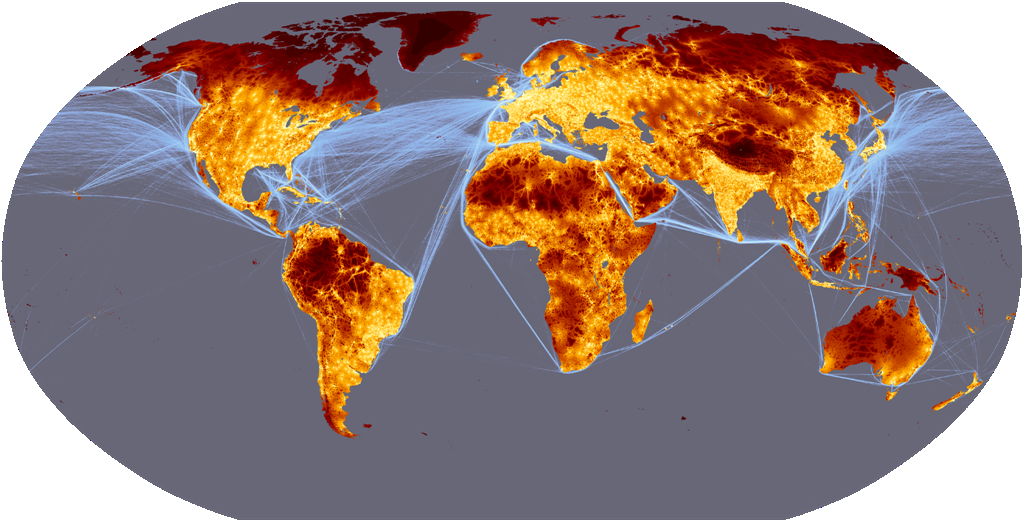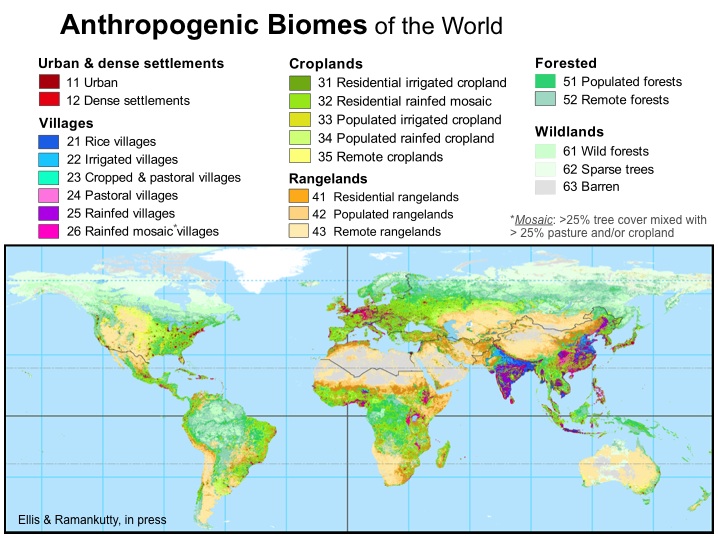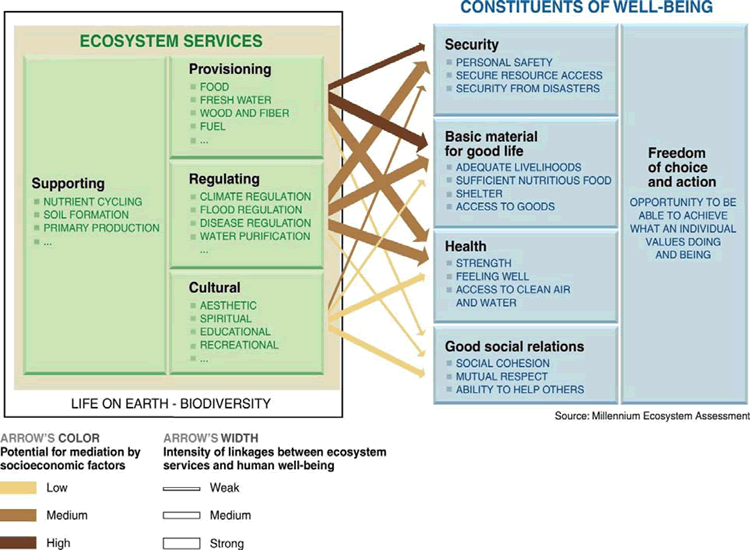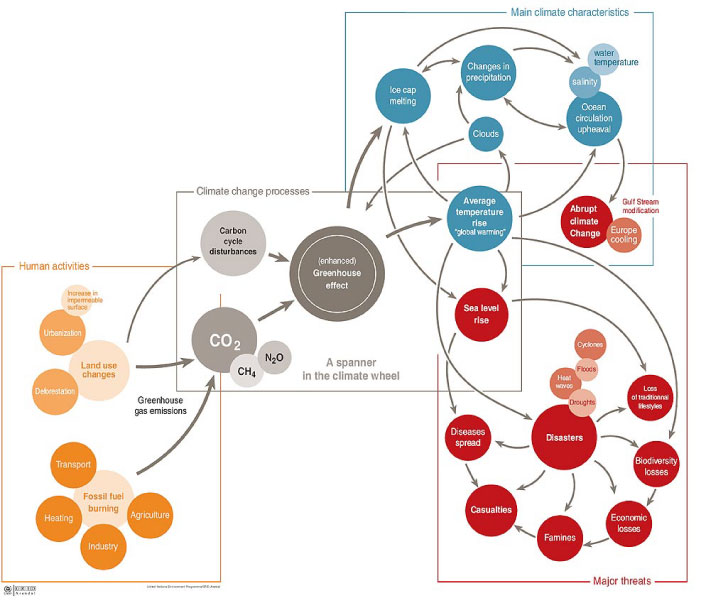
The Anthropocene
What Is It?
New geological ages are characterized by changes in global environmental conditions and large scale shifts in types of species. Recently Earth has entered into a new geological age: The Anthropocene, from anthropo = man and cene = new [geological age]. Humans are now changing the world on a global scale and ushering in the new era in geologic time.
In a feat unprecedented for a single animal species, humanity's total energy use has now exceeded that of the entire ancient biosphere before oxygenic photosynthesis, reaching about a tenth of the energy processed by today's biosphere.
From Lenton (2008).The biosphere itself, at all levels from genetic to the landscape, is increasingly a human product.
(Allenby, 2000: 15).The interactions between environmental change and human societies have a long and complex history, spanning many millennia. They vary greatly through time and from place to place. Despite these space and time differences, in recent years a global perspective has begun to emerge that forms the framework for a growing body of research within the environmental sciences. Crucial to the emergence of the this perspective has been the dawning awareness of two fundamental aspects of the nature of the planet. The first is that the Earth itself is a single system, within which the biosphere is an active essential component. In terms of a sporting analogy, life is a player, not a spectator. Second, human activities are now so pervasive and profound in their consequences that they affect the Earth at a global scale in complex, interactive and accelerating ways; humans now have the capacity to alter the Earth System in ways that threaten the very processes and components, both biotic and abiotic, upon which humans depend.
From International Geosphere Biosphere Program (2001), page 4.For all but the past 100–200 years of human history, humanity was clearly only a passenger on Spaceship Earth. But now, humankind has stepped out of its passenger seat and is wrestling the previous "pilots" for control of the ship. This seems a very dangerous course of action, as long as we don't know how the craft responds to perturbations, how the controls are wired, and what all the indicators signaling change are really trying to tell us.
Andraea (2002) page 2.
Evidence of Human Change of the Planet
Our analysis indicates that 83% of the earth's land surface is influenced directly by human beings, whether through human land uses, human access from roads, railways or major rivers, electrical infrastructure (indicated by lights detected at night), or direct occupancy by human beings at densities above 1 person per km2. We refer to the human influence on the land’s surface measure as the "Human Footprint."
Last of the Wild Project, Center for International Earth Science Information Network (CIESIN), Earth Institute at Columbia University.
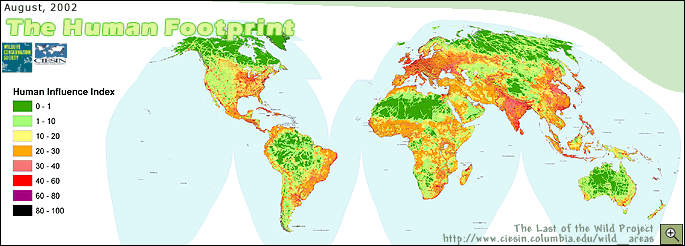
Human Influence on Earth. Click on image for a zoom.
From Last of the Wild Project, Center for International Earth Science Information Network (CIESIN), Earth Institute at Columbia University.
In the past hundred years, we have seen:
- The complete conversion of 15% of all ice-free land surface to human use.
- The partial conversion of 55% of all ice-free land surface to human use.
- The fixation (conversion of atmospheric nitrogen into fertilizer) of 190 megatons of nitrogen per year (in 2005), compared with pre-agriculture terrestrial fixation of 150-190 megatons of nitrogen per year by natural processes (Smil, 2000: 248) In addition, burning of fossil fuels and industrial processes released 100 megatons of nitrogen oxides and ammonia into the atmosphere in 1995 (Galloway (2008).
- The appropriation of 25% to 40% of total net primary productivity of the planet for human use.
- Changes in the composition of the atmosphere.
- The damming of most of the world's rivers. Humans have extensively altered river systems through impoundments and diversions to meet their water, energy, and transportation needs. Today, there are > 45,000 dams above 15 m high, capable of holding back > 6500 km3 of water (1), or about 15% of the total annual river runoff globally. (Nillson et al, 2005).
- The beginning of a massive extinction of life, about one species every 20 minutes (Wilson, 1992). One fifth of all species will be gone by 2030 if the present rate continues (Wilson, 2003: 102).
- The total biomass of the world's population increased to roughly 40 megatons of carbon. To put this number into perspective, consider: The biomass of all life is roughly 500 Gigatons of carbon, the biomass of all wild vertebrates on land is roughly 5 megatons, and the biomass of all vertebrates in the ocean is about 50 megatons of carbon. We have eight time the mass of all wild land vertebrates, and about the same biomass as all the fish and whales in the ocean. Domesticated animals have a biomass of roughly 100 megatons of carbon. The biomass of our animals is about 20 times the mass of all wild vertebrates on land, and 50% larger than the mass of all vertebrates in the ocean. Smil (2002: 186, 283–284).
- The mass of all motor vehicles is roughly 1,000 megatons. "Machines now need more carbon every year than humans do. The global food harvest now amounts to about 1.3 gigatons of carbon per year, whereas almost 1 gigaton of fossil carbon is used annually to produce metals and plastic from which machines are assembled, and about 4 gigatons of carbon are used each year to power them." Smil (2002: 269).
- The ability to reach almost any point on land within 48 hours. "Wilderness?
Only 10% of the land area is remote – more than 48 hours from
a large city." Travel
time to major cities: A global map of Accessibility.
Time to reach a place on land from a nearby major city.
From Travel time to major cities: A global map of Accessibility.
When Did It Start?
The exact beginning of the anthropocene is still being debated, but Paul Crutzen and Eugene Stoermer have proposed that the anthropocene starts in the 18th century.
To assign a more specific date to the onset of the 'anthropocene" seems somewhat arbitrary, but we propose the latter part of the 18th century, although we are aware that alternative proposals can be made (some may even want to include the entire holocene). However, we choose this date because, during the past two centuries, the global effects of human activities have become clearly noticeable. This is the period when data retrieved from glacial ice cores show the beginning of a growth in the atmospheric concentrations of several 'greenhouse gases", in particular C02 and CH4. Such a starting date also coincides with James Watt's invention of the steam engine in 1784. About at that time, biotic assemblages in most lakes began to show large changes.
From The Anthropocene by Paul Crutzen and Eugene F. Stoermer (2000).
Cause
The anthropocene is the result of the vast expansion of human populations. If there were only a few million people on earth, we would not be changing the planet. But six and a half billion people are enough to produce important and noticeable changes.
Video of Population Growth
View this video, showing the growth of population on a map
of the world, from 1 AD until the present. Each dot on the map represents
1,000,000 people. (This is a high-resolution video, click on the box
in the lower right to view full screes). Growth is exponential, with
most people being born in the last few decades.
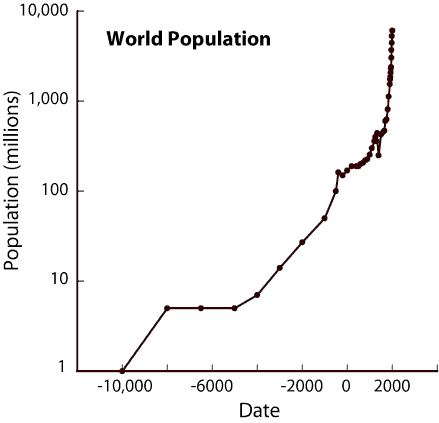
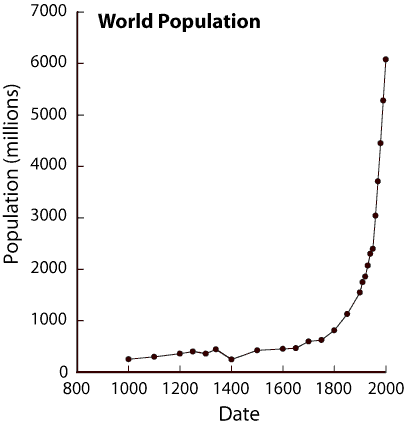
World Population: Left: Since prehistoric
times (log scale), Right: Since
800 AD (linear scale). Drawn using data from US Census Bureau, Historical
Estimates of World Population, and World
Population 1950-2050. The recent, rapid increase of population led
to the anthropocene. Note that the population is now increasing at the
rate of one billion people every 13 years.
The rate of population increase has been slowing. Still, we, as environmental geoscientists, must face the problem: What will happen to earth if the population continues to increase?
Effects
Biome
Biomes organize the biological
communities of the earth based on similarities in the dominant vegetation,
climate, geographic location, and other characteristics (Biomes:
Encyclopedia of Earth). In the past, they included deserts, tropical
rain forests, tundra, freshwater streams and lakes, grasslands, estuaries,
and open ocean. Now, all are influenced by people. Nature is imbedded
within human systems according to Erle Ellis and Navin Ramankutty.
They propose to replace the older biomes with new anthropogenic biomes
based on the human influence on ecosystems.
Ecology needs to move beyond human footprints, impacts and domination. Ecosystem processes in anthropogenic biomes are primarily a function of human populations and their ecosystem interactions (land use). Forests, rangelands & croplands include people. Trees [are] mixed with croplands and housing. Anthropogenic landscapes are heterogeneous mixtures of different land use and land cover classes.
From Ellis and Ramankutty, Anthropogenic Biomes: A 21st century framework for ecology and the earth sciences. See: Anthropogenic Biomes article in Encyclopedia of Earth.
Ecosystem Goods and Services
Earth System processes provide environmental goods and services that sustain life and are essential for human well-being. These "ecosystem goods and services" include potable water, fertile soil, clean air and flood mitigation. Throughout history these have largely been taken for granted, because they were not significantly affected by human activities ... The magnitude of the human impacts on the environment – including direct effects of biogeochemical cycles, now threatens the quality and long-term delivery of ecosystem goods and services.
From Global Land Project Transition Team (2005).
The water, food, fuel, fiber, oxygen, clean air, and places to live that we depend on are threatened.
As the world's population increases, we are reducing the ability of the systems to provide the services we need. Often, we are demanding more services than the ecosystems can provide. We may be reaching the point beyond which we cannot sustain our societies. Notice I wrote "may be." In 1798 Thomas Malthus published An Essay on the Principles of Population, then in 1968 Paul Erlich published his book The Population Bomb, and in 1972 the Club of Rome published the best selling environmental book in history, Limits to Growth. All sounded similar warnings. Then came the industrial revolution, the green revolution, increased food supplies, conservation of some resources, and the discovery of new resources. Today there are many more people enjoying life. Clearly, we are stressing the ability of earth to provide some services. But, we are not quite sure how close we are to the tipping point of an unsustainable future.
It's tough to make predictions, especially about the future.– Yogi Berra.
The Millennium Ecosystem Assessment Report of 2005 is the latest report to discuss the limits to growth. The report states we are using some resources faster than they can be replenished:
- At least one quarter of important commercial fish stocks are over harvested.
- From 5% to possibly 25% of global freshwater use exceeds long-term accessible supplies.
- Some 15–35% of irrigation withdrawals exceed supply rates and are therefore unsustainable.
- Reduction in stratospheric ozone is leading to increased UV radiation at earth's surface and to possibly more skin cancer.
- Changes to ecosystems have contributed to a significant rise in the number of floods and major wildfires on all continents since the 1940s.
- Actions to increase one ecosystem service often cause the degradation
of other services.
Global Climate Change
Human activity has altered Earth's carbon and energy
budget and other processes from the stratosphere, through the atmosphere
to the land and down to the bottom of the sea. The figure shows the many
ways we alter the nitrogen cycle, and some of the many feedback loops
in the system.
The influence of human activity on the climate system. Click on image for a zoom.
Image from UNESCO GRID-Arendal Vital Graphics-Climate Change.
References
- Allenby, B. (2000). Earth systems engineering and management. IEEE Technology and Society Magazine 19(4): 10-24.
- Andraea, Meinrat O. 2002. Humanity: passenger or pilot on spaceship earth? Global Change Newsletter, December 2002, pages 2–7.
- Crutzen, P. J. and E. F. Stoermer (2000). The Anthropocene.
Global Change Newsletter (41): 17--18 (PDF file)
- Galloway, J. N., A. R. Townsend, et al. (2008). Transformation
of the Nitrogen Cycle: Recent Trends, Questions, and Potential Solutions.
Science 320 (5878): 889-892.
Humans continue to transform the global nitrogen cycle at a record pace, reflecting an increased combustion of fossil fuels, growing demand for nitrogen in agriculture and industry, and pervasive inefficiencies in its use. Much anthropogenic nitrogen is lost to air, water, and land to cause a cascade of environmental and human health problems. Simultaneously, food production in some parts of the world is nitrogen-deficient, highlighting inequities in the distribution of nitrogen-containing fertilizers. Optimizing the need for a key human resource while minimizing its negative consequences requires an integrated interdisciplinary approach and the development of strategies to decrease nitrogen-containing waste. - Global Land Project Transition Team (2005) Global Land Project: Science Plan and Implementation Strategy. International Geosphere Biosphere Report 53.
- International Geosphere Biosphere Program. (2001). Global Change and the Earth System: A Planet Under Pressure, IGBP Science No. 4. The Role of Population.
- Lenton, T. (2008). Engines of life. Nature 452
(7188): 691-692. Book review of Energy in Nature
and Society by Vaclav
Smil.
- Nilsson, C., C. A. Reidy, et al. (2005). "Fragmentation and Flow Regulation of the World's Large River Systems." Science 308(5720): 405-408.
- Smil, Vaclav (2002) The Earth's Biosphere: Evolution, Dynamics, and Change. MIT Press.
- Wilson, Edward O. (1992) The Diversity of Life. Belknap.
- Wilson, Edward O. (2003) The Future of Life. Vintage Books.
Revised on: 29 May, 2017

